In today’s competitive talent landscape, employee retention is more crucial than ever. Data from 2025 reveals that over 51% of employees are actively searching for new jobs, and nearly 42% of employee turnover is preventable with the right retention strategies.
Every departure is not just a loss of talent but also a significant cost to organizations, impacting productivity, morale, and business outcomes.
HR leaders must therefore double down on proactive retention tactics that engage employees at every stage, from hiring to career milestones, creating an environment where people want to stay, grow, and thrive.
This article dives deep into proven strategies organizations can implement to retain their top talent effectively.
Key Takeaways
- Keeping top talent starts with creating a workplace where people feel valued, heard, and see clear growth. This is the secret sauce for retention.
- Flexibility isn’t just a perk anymore; it’s a must-have. Offering flexibility shows you care about your employees’ whole lives, not just office hours.
- Career development is the ultimate loyalty booster. When employees see you’re invested in their future, they stick around and grow with you.
- Recognition and strong leadership are twin engines that drive engagement and make employees excited to stay and contribute.
- Clear roles and open communication help eliminate confusion, making your team confident, aligned, and less likely to look elsewhere.
Why Employee Retention Is a Big Deal in 2025
Employee retention directly influences a company’s financial health and organizational culture. Losing employees costs U.S. businesses over $700 billion annually, with replacement costs averaging up to 200% of an employee’s salary for senior roles.
Turnover disrupts team dynamics, hampers knowledge continuity, and damages employer brand reputation, making recruiting and training new employees both time-consuming and costly.
High retention rates foster stable, productive teams, enabling companies to maintain competitive advantages and deliver consistent results. By investing in employee retention, businesses not only save money but also build a loyal workforce that drives innovation and success.
The True Cost of Employee Turnover
When an employee leaves, it’s not just about posting a job and hiring someone new. Turnover hits a company in more ways than most realize, impacting finances, team energy, and long-term success.
- Hiring new employees involves recruitment fees, onboarding costs, and lost productivity.
- Soft costs include morale loss, disrupted client relationships, and knowledge transfer gaps.
- Leadership vacancies often incur the highest replacement costs, amplifying the financial impact.
Impact on Company Culture and Productivity
The ripple effect of frequent goodbyes is real. Watch as team spirit and company performance get tested every time someone exits.
- Frequent turnover leads to lower team cohesion and increased workload on remaining staff.
- High turnover can lower engagement scores, creating a cycle of continued attrition.
Competitive Advantage Through Retention
Strong retention isn’t just about saving money; it’s also about building a brand and workplace others want to join.
- Companies with strong retention rates attract top talent more easily.
- Engaged, long-term employees contribute more significantly to growth and innovation.
Also Read: 10 Surprising Facts About Employee Retention
What Really Makes Employees Walk Out the Door?
To retain employees, organizations must understand why they choose to leave. Recent studies highlight primary drivers such as limited career growth, inadequate pay, burnout, and poor recognition.
Recognizing these reasons allows organizations to address root causes rather than symptoms, crafting targeted retention programs.
- Career stagnation and lack of development opportunities.
- Compensation dissatisfaction and unclear pay structures.
- Work-related stress, burnout, and poor work-life balance.
- Inadequate recognition and weak leadership.
- Misalignment with company values or culture.
Early Warning Signs and Predictive Analytics
The first cracks in employee engagement often show up quietly, long before resignations hit HR’s desk. Predictive analytics helps you spot those signals early, giving you a chance to act before talent walks out.
- Employee disengagement is detected through pulse surveys and feedback.
- Increased absenteeism or declining performance.
- Exit interview data helps identify patterns for preemptive action.
Demographic Differences in Turnover Risk
Not every employee leaves for the same reason. Age, career stage, and priorities play a huge role in shaping turnover risks. Recognizing these differences allows you to design retention strategies that resonate with each group.
- Younger employees may prioritize career growth and flexibility.
- Senior talent focused on recognition, purpose, and leadership quality.
- Customized strategies improve retention across diverse employee groups.
Pay Fairly and Be Crystal Clear About It
Compensation remains one of the most critical elements influencing employee retention. Studies consistently show that fair and competitive pay is a primary reason employees stay or leave an organization.
However, it is not just about the amount, but also about transparency in how compensation decisions are made that fosters trust and reduces turnover.
Key aspects of competitive & transparent pay include:
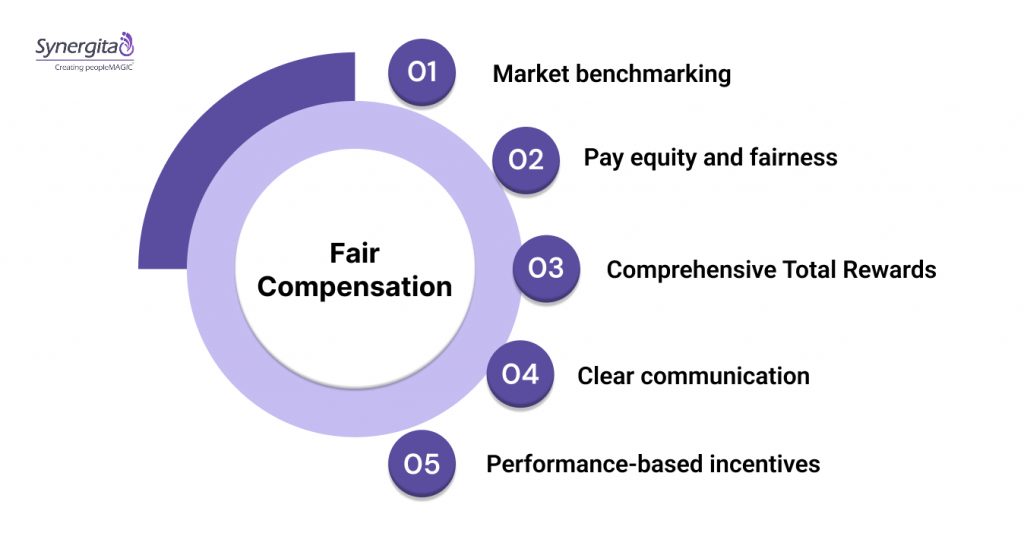
- Market benchmarking: Regularly assess your pay scales against industry standards and regional competition to ensure market competitiveness. This prevents talent leakage to competitors and signals that your company values skill and experience fairly.
- Pay equity and fairness: Conduct frequent pay equity audits to identify and address disparities related to gender, ethnicity, or role. Transparent communication about how pay decisions are made can create a sense of fairness that improves retention, especially among underrepresented groups.
- Comprehensive Total Rewards: Beyond base salary, employees value bonuses, stock options, retirement benefits, health plans, and perks like childcare support. Highlighting the full compensation package helps employees appreciate total value and deepens loyalty.
- Clear communication: Use open dialogue and documentation to explain pay structures, raise criteria, and reward cycles. Employees who understand how compensation is calculated feel less uncertainty and are more engaged.
- Performance-based incentives: Reward achievements and milestones fairly with bonuses, promotions, and spot awards. Linking pay to performance reinforces behaviors that align with company goals and keeps employees motivated.
Use Synergita to analyze data, track sentiment, and communicate rewards to strengthen your pay transparency efforts and boost retention. Book A Demo Now
Make Flexibility & Balance Work for Everyone
In 2025, flexible work options have shifted from perks to expectations. Employees’ priorities have changed with evolving lifestyles and a greater emphasis on mental health.
Flexible arrangements, including hybrid work, remote options, and flexible schedules, have been shown to reduce voluntary turnover.
These options not only support diverse personal needs but also foster a culture of trust, autonomy, and well-being.
Strategies to promote flexibility include:
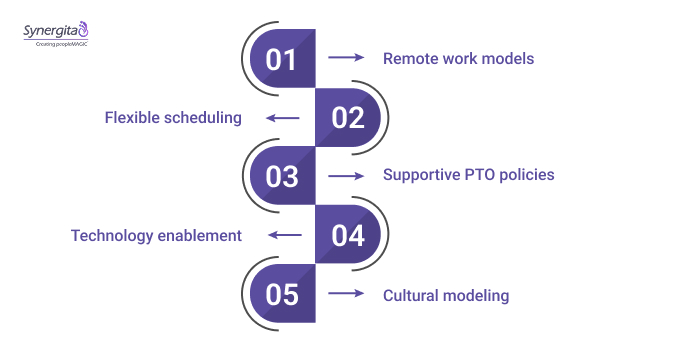
- Hybrid and remote work models: Design policies that enable employees to choose remote, hybrid, or in-office work based on job role and individual preferences. Flexibility allows employees to create work environments where they are most productive while staying connected.
- Flexible scheduling: Allow staggered start/end times, compressed workweeks, or core hours to accommodate caregiving, education, and personal obligations.
- Supportive PTO policies: Encourage full use of paid time off and mental health days. Discourage burnout by limiting after-hours work expectations and promoting “digital detox” periods.
- Technology enablement: Provide tools and platforms that facilitate seamless communication, collaboration, and access regardless of where employees log in.
- Cultural modeling: Leaders should visibly prioritize work-life balance, leading by example and encouraging teams to respect boundaries.
Impact on retention: Companies providing flexible work options enjoy higher engagement and job satisfaction, which are key retention drivers. Employees with work-life harmony report lower stress and greater commitment to employers.
Help People Grow so Your Company Grows Too
Career growth is a critical factor driving employee retention. Employees want to feel their long-term success matters, and 94% say they are more likely to stay if their employers invest in development opportunities.
Organizations that prioritize continuous learning, clear advancement pathways, and internal mobility foster commitment and reduce turnover.
Key components in development and mobility include:
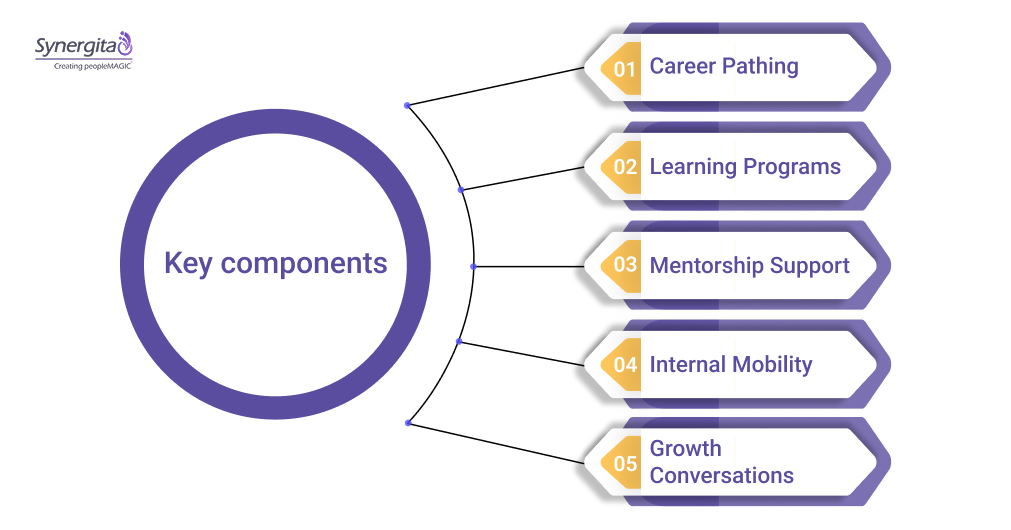
- Skills-based career pathing: Map career journeys anchored in relevant skills and competencies, including soft skills and leadership capabilities. This creates transparent roadmaps from entry to leadership levels.
- Learning and development programs: Offer formal training, certifications, coaching, and mentorship programs, enabling employees to build capabilities and confidence continuously.
- Mentorship programs: Match employees with experienced mentors for guidance, network expansion, and support.
- Internal mobility platforms: Make it easy for employees to explore openings or lateral paths within the organization, reducing the need to look elsewhere.
- Regular growth conversations: Use structured one-on-one check-ins to align personal aspirations with organizational opportunities.
Impact: Organizations investing in employee growth see up to a 58% increase in retention rates. Career-focused employees are more engaged, motivated, and loyal, warding off turnover motivated by job dissatisfaction.
Also Read: Five Best Methods for Talent Retention and Utilization
Mental Health and Well-Being Matter More Than Ever
Growing research shows well-being investments pay off by reducing costly turnover and boosting engagement. Addressing physical, emotional, and financial wellness creates healthier, more resilient workforces.
Effective well-being strategies include:
- Employee Assistance Programs (EAPs): Confidential counseling and support services for mental health, addiction, financial stress, and family issues.
- Stress management and mindfulness programs: Workshops, apps, and peer support groups to foster resilience, reduce burnout, and promote a positive mindset.
- Financial wellness support: Education, planning tools, and emergency aid to ease financial worries.
- Flexible benefits and wellness stipends: Incentivize preventive care, fitness, and healthy lifestyle choices.
- Workload management: Cultivate balanced workloads, avoiding chronic overwork and emphasizing task prioritization.
- Open dialogue about mental health: Destigmatize wellness discussions to encourage early help-seeking.
Implementing robust well-being programs directly addresses employee concerns that drive turnover. Healthy employees are more productive, connected, and likely to stay long term.
Also Read: The Link Between Employee Engagement and Employee Retention
Build a Culture Where Everyone Belongs and Finds Purpose
Employees who feel a sense of belonging and shared purpose are 41% less likely to leave. Inclusion, diversity, and values alignment foster emotional stickiness and unlock innovation.
Steps to cultivate an inclusive culture and purpose:
- DEI programs: Implement ongoing diversity, equity, and inclusion efforts that go beyond hiring to create a welcoming environment for all.
- Meaningful values communication: Regularly share organizational mission and values, linking daily work to a larger impact.
- Belonging initiatives: Support affinity groups, mentorship, and open dialogue.
- Recognize diverse contributions: Celebrate different perspectives and achievements.
- Leadership commitment: Leaders demonstrate inclusive practices and embrace transparency.
Inclusive companies attract diverse talent and prevent turnover caused by exclusion or bias. Employees immersed in purpose-driven environments bring greater energy and loyalty.
Use Synergita’s culture and engagement tools to measure belonging and purpose alignment, informing continuous improvement. It provides sentiment analysis to detect well-being trends, enabling timely, targeted wellness interventions.
Say ‘Thank You’ in Ways That Really Count
Recognition is a retention multiplier. Underappreciated employees are twice as likely to quit. Conversely, those who feel genuinely appreciated are 5 times more likely to stay and perform better.
Effective recognition practices:
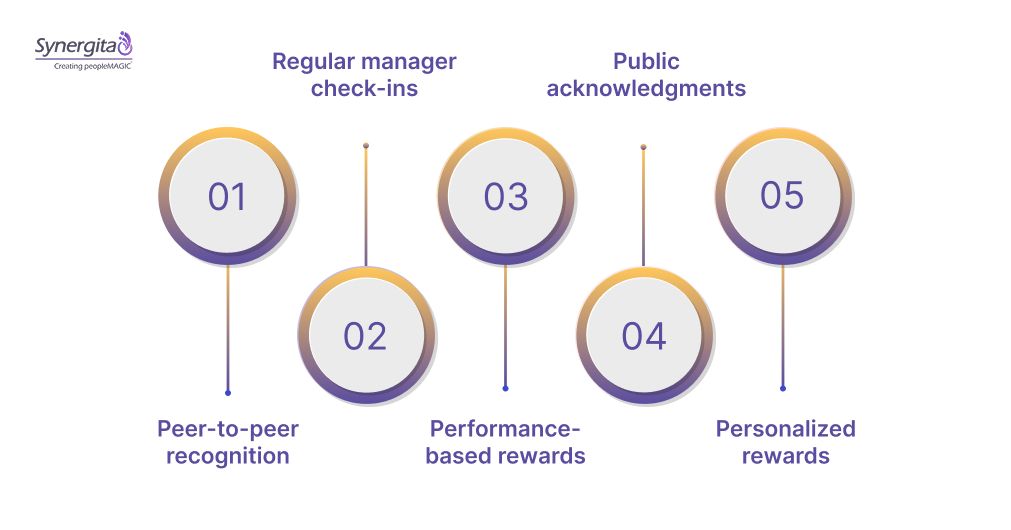
- Peer-to-peer recognition: Empower employees to recognize colleagues for everyday contributions, creating a positive, inclusive atmosphere.
- Regular manager check-ins: Reinforce appreciation during individual conversations.
- Performance-based rewards: Bonuses, promotions, and incentives aligned to achievement.
- Public acknowledgments: Celebrate success stories in town halls, newsletters, and online channels.
- Personalized rewards: Tailor recognition based on employee preferences and motivations.
Recognition nurtures trust, engagement, and emotional commitment. It signals to employees that their efforts matter beyond task completion.
Also Read: How Employee Feedback Loops Increase Employee Retention
Ensure Clear Roles, Expectations, and Communication
Uncertainty in roles and a lack of dialogue cause disengagement. Studies show that 45% of employees who quit never had conversations about job satisfaction with their managers.
Strategies for clarity and communication:
- Role clarity: Define responsibilities, scope, and authority clearly in job descriptions and team documents.
- Goal setting and performance discussions: Use SMART objectives and regular feedback loops.
- Stay interviews: Proactively discuss satisfaction and career plans.
- Transparent communication: Foster open, honest dialogue about expectations, changes, and progress.
- Training for managers: Equip leaders to communicate effectively and empathetically.
Clear roles and communication empower employees, boosting confidence, accountability, and retention.
Synergita’s performance management modules streamline goal tracking and facilitate continuous conversations.
Lead with Empathy: Build Supportive Leaders Who Care
Leadership quality is the top predictor of retention. Poor management causes over 42% of voluntary turnover. Conversely, skilled, empathetic leaders build trust, support, and purpose.
Leadership retention strategies:
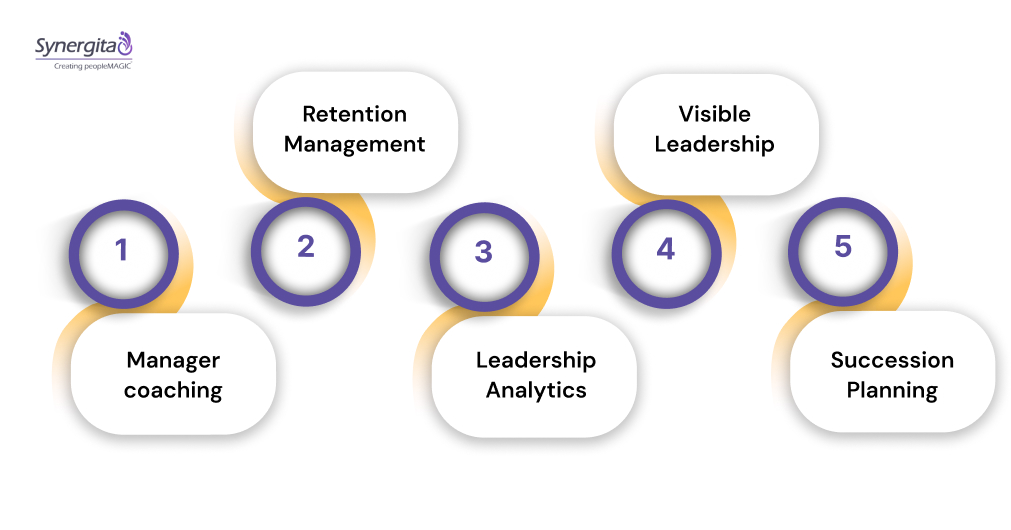
- Manager coaching: Train leaders in emotional intelligence, delegation, and feedback.
- Retention-focused management: Incorporate retention objectives into leadership evaluations.
- Use of analytics: Identify leadership impact on turnover and engagement.
- Visible, accessible leadership: Foster transparency and approachability.
- Succession planning: Prepare next-generation leaders focused on retention.
Strong leadership nurtures positive work environments, reduces exit rates, and inspires peak performance.
Also Read: Why Continuous Feedback is Important to Predict Employee Attrition
Conclusion
Employee retention in 2025 goes beyond salary; it demands an integrated approach encompassing compensation, culture, leadership, development, and well-being.
Companies that invest in targeted, data-driven retention strategies reduce costly turnover and create vibrant workplaces where employees stay and thrive.
HR leaders must prioritize clear communication, inclusivity, and continuous improvement to build resilient, motivated teams.
Leveraging advanced tools like Synergita can amplify these efforts, enabling real-time insights and agile action for sustained success.
Partner with Synergita to unlock powerful engagement, retention, and talent development solutions that transform your workforce and future-proof your business.
Frequently Asked Questions (FAQs)
1. What is employee retention?
Employee retention is how well a company keeps its employees and lowers turnover. It means creating a positive work environment where people feel valued and want to stay long-term. Good retention saves money on hiring and training, keeps teams stable, and boosts overall business success by maintaining knowledge and continuity.
2. Why is retaining employees important?
Keeping employees reduces high costs of recruiting and onboarding replacements. It sustains productivity by preserving experienced workers with deep skills. Stable teams improve morale and company culture, leading to stronger performance and less disruption. Retention also builds loyalty and commitment, helping the business grow steadily without constant staffing challenges.
3. What are the top ways to retain employees?
Offer competitive salaries, career growth paths, and flexible work options. Recognize and appreciate contributions regularly. Maintain clear communication and set expectations. Support employees with strong leadership and foster an inclusive culture where everyone feels they belong. These combined create an environment that encourages loyalty and long-term engagement.
4. How can companies improve communication for retention?
Clarify roles and responsibilities so employees know what’s expected. Give regular, honest feedback to support development. Conduct stay interviews to understand concerns before employees leave. Encourage open and transparent communication to build trust and make employees feel valued, which reduces uncertainty and turnover likelihood.
5. Does employee recognition really impact retention?
Yes, truly valuing employees through regular recognition greatly increases motivation and loyalty. When people know their work matters and their efforts don’t go unnoticed, they’re more invested in staying and contributing. Recognition builds a positive emotional connection that strengthens the employee-employer relationship.
6. What role does leadership play in keeping employees?
Leaders set the tone for engagement and trust. Effective leaders listen, support, and show empathy, making employees feel safe and valued. When leadership is strong and approachable, turnover drops because employees want to stay with managers who invest in their growth and well-being.
7. Is work-life balance essential for retention?
Absolutely. When employees can manage work around personal commitments, burnout lowers significantly. Flexible schedules, respect for off-hours, and support for well-being make employees happier and more committed. Work-life balance is critical for retaining talent in today’s demanding work environment.
8. How can career development aid retention?
Providing clear paths for growth and upskilling keeps employees engaged. Opportunities for advancement or lateral moves within the company reduce the urge to seek new jobs elsewhere. Investing in employee development shows the company values its future, increasing loyalty and retention.



